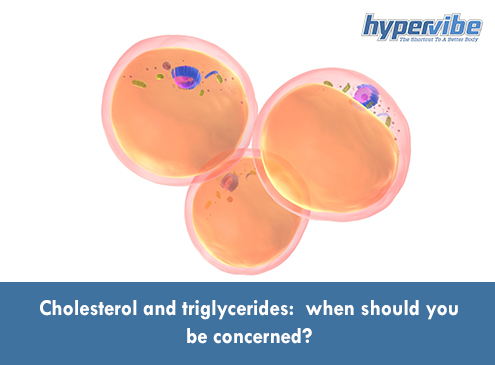Cholesterol and triglycerides: when should you be concerned?

Cholesterol is often mistaken for fat, but the two aren’t the same thing: technically, cholesterol is a soft, waxy fat-like substance, but not pure fat. It is produced by the liver and isn’t bad in itself; in fact, the body needs cholesterol for a variety of processes, from the production of hormones to maintaining the health of all cells and tissues.
However, cholesterol can become threatening in certain conditions. If the organism produces more of this substance than it needs, and your diet adds even more, then this substance can become a dangerous one for your health, and especially for the cardiovascular system.
In a healthy organism, the body produces all the cholesterol it needs for making hormones and vitamin D, and for digesting food. This substance travels through the bloodstream together with a protein in “packages” called lipoproteins, which contain the lipid on the inside and the protein on the outside.
Some proteins are of low density (LD), others are of high density (HD), and your body needs both of them as long as the levels remain normal. For LDL (low-density lipoprotein), the blood level should remain under 100. If your LDL goes up, then the LDL that circulates through the blood vessels can deposit cholesterol in the walls of the vessels, leaving it there.
These little deposits don’t seem threatening at the beginning but over the years they build up and being sticky, they capture other substances and debris that travels through the bloodstream as well, such as calcium or waste products. And when this happens, the substances get stuck and they contribute to the formation of plaque, which is the cause of atherosclerosis.
HDL on the other hand carries the cholesterol back to the liver, and then the liver removes it from the body. As long as the level of HDL in your blood is higher than the level of LDL, the risk of developing atherosclerosis remains low. Ideally, HDL levels should be over 50.
It’s worth mentioning that women tend to have higher levels of “good” (HDL) cholesterol than men, and that a good strategy for keeping cholesterol levels under control is to watch your diet and maintain a healthy weight. If you’re overweight, lose some pounds, and pay attention especially to your waistline, as the fat around the waist is the one that releases hormones and proteins that can increase the values of bad cholesterol.
Triglycerides: when are they dangerous and how to maintain normal values
Triglycerides are fats: they’re made by the liver or taken from the foods you eat, and carried through the blood stream to cells and tissues to be stored. To prevent health issues, you should aim for triglycerides values under 100, although some sources say 150 it’s also a safe value. But in lots of people, such a high level of triglycerides is associated with other problems, and it becomes threatening for their cardiovascular system.
A high level of these substances increases the risk of coronary artery disease, metabolic syndrome and diabetes, but the good news is that the levels of triglycerides can be quickly reduced by cutting animal fat and sugar from your diet. So if your waistline is larger than it used to be and your triglycerides are high, some diet and lifestyle changes can help solve these issues.
Triglycerides are used inside your body for energy, but anything that’s above 150 is considered high, and values over 200 are already dangerous for your health. Potential causes of high triglycerides include obesity and diabetes, kidney disease, hypothyroidism, but also drinking too much alcohol or eating more calories than your body burns.
Some medicines like birth control pills, estrogen, steroids, and even diuretics can also contribute to higher than normal levels of these substances. Also, genetics may play a role, although in most people it’s their lifestyle and diet habits that cause the increased triglycerides values.
Now, neither cholesterol nor triglycerides don’t cause visible symptoms at the beginning, and they can build up in time, so sometimes it takes years until these high values are diagnosed. Of course, if you’re overweight or suffer from diabetes for example, or your waistline is very large, you can assume your levels of these compounds are also higher than normal and you should test them.
But if you’re not sure whether you have normal values of cholesterol and triglycerides, and you don’t want to undergo any test, the best solutions for preventing their accumulation is to exercise daily, to limit sugar and fat in your diet and maintain a healthy weight, and to reduce the consumption of alcohol.
Have something to add to this article? Comment below or join our Facebook community and share your thoughts with us.










